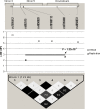Identification of PLCL1 gene for hip bone size variation in females in a genome-wide association study
- PMID: 18776929
- PMCID: PMC2522269
- DOI: 10.1371/journal.pone.0003160
Identification of PLCL1 gene for hip bone size variation in females in a genome-wide association study
Erratum in
- PLoS ONE. 2009;4(2). doi: 10.1371/annotation/951f0d10-0b78-4d6b-94c9-8ae6cc4178dd. Chinnapen-Horsley, Usha [corrected to Chinappen-Horsley, Usha]; Cervino, Alesandra [corrected to Cervino, Alessandra]
Abstract
Osteoporosis, the most prevalent metabolic bone disease among older people, increases risk for low trauma hip fractures (HF) that are associated with high morbidity and mortality. Hip bone size (BS) has been identified as one of the key measurable risk factors for HF. Although hip BS is highly genetically determined, genetic factors underlying the trait are still poorly defined. Here, we performed the first genome-wide association study (GWAS) of hip BS interrogating approximately 380,000 SNPs on the Affymetrix platform in 1,000 homogeneous unrelated Caucasian subjects, including 501 females and 499 males. We identified a gene, PLCL1 (phospholipase c-like 1), that had four SNPs associated with hip BS at, or approaching, a genome-wide significance level in our female subjects; the most significant SNP, rs7595412, achieved a p value of 3.72x10(-7). The gene's importance to hip BS was replicated using the Illumina genotyping platform in an independent UK cohort containing 1,216 Caucasian females. Two SNPs of the PLCL1 gene, rs892515 and rs9789480, surrounded by the four SNPs identified in our GWAS, achieved p values of 8.62x10(-3) and 2.44x10(-3), respectively, for association with hip BS. Imputation analyses on our GWAS and the UK samples further confirmed the replication signals; eight SNPs of the gene achieved combined imputed p values<10(-5) in the two samples. The PLCL1 gene's relevance to HF was also observed in a Chinese sample containing 403 females, including 266 with HF and 177 control subjects. A SNP of the PLCL1 gene, rs3771362 that is only approximately 0.6 kb apart from the most significant SNP detected in our GWAS (rs7595412), achieved a p value of 7.66x10(-3) (odds ratio = 0.26) for association with HF. Additional biological support for the role of PLCL1 in BS comes from previous demonstrations that the PLCL1 protein inhibits IP3 (inositol 1,4,5-trisphosphate)-mediated calcium signaling, an important pathway regulating mechanical sensing of bone cells. Our findings suggest that PLCL1 is a novel gene associated with variation in hip BS, and provide new insights into the pathogenesis of HF.
Conflict of interest statement
Figures



References
-
- Seeman E, Duan Y, Fong C, Edmonds J. Fracture site-specific deficits in bone size and volumetric density in men with spine or hip fractures. J Bone Miner Res. 2001;16:120–127. - PubMed
-
- Deng HW, Xu FH, Davies KM, Heaney R, Recker RR. Differences in bone mineral density, bone mineral content, and bone areal size in fracturing and non-fracturing women, and their interrelationships at the spine and hip. J Bone Miner Metab. 2002;20:358–366. - PubMed
-
- Havill LM, Mahaney MC, Binkley L, Specker BL. Effects of genes, sex, age, and activity on BMC, bone size, and areal and volumetric BMD. J Bone Miner Res. 2007;22:737–746. - PubMed
-
- Fang Y, van Meurs JB, Rivadeneira F, van Schoor NM, van Leeuwen JP, et al. Vitamin D receptor gene haplotype is associated with body height and bone size. J Clin Endocrinol Metab. 2007;92:1491–1501. - PubMed
-
- Lei SF, Deng FY, Xiao SM, Chen XD, Deng HW. Association and haplotype analyses of the COL1A2 and ER-alpha gene polymorphisms with bone size and height in Chinese. Bone. 2005;36:533–541. - PubMed
Publication types
MeSH terms
Substances
Grants and funding
LinkOut - more resources
Full Text Sources
Medical
Molecular Biology Databases
Research Materials
Miscellaneous

